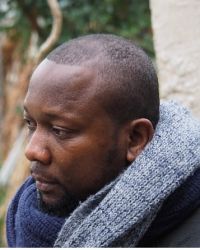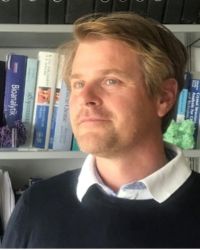Structural Bioenergetics
Proton pumping NADH:ubiquinone oxidoreductase (complex I) is a 1 MDa membrane protein complex with a key function for efficient energy production of the cell. Complex I utilizes the redox energy released in the electron transfer reaction from NADH to ubiquinone to pump protons across the inner mitochondrial membrane or the cell membrane of bacteria. Redox-linked proton translocation by complex I contributes considerably to the electrochemical proton gradient that ultimately drives ATP synthesis in oxidative phosphorylation. A variety of neuromuscular and neurodegenerative human diseases have been linked with complex I dysfunction. However, the molecular details of energy conversion by complex I are still controversial and we are just beginning to understand how this intricate molecular machine is assembled.
We use the aerobic yeast Yarrowia lipolytica as a model organism to study mitochondrial complex I. We have determined the high-resolution cryoEM structure of the enzyme complex in an ongoing collaboration with the MPI Biophysics, Frankfurt. Recently, we have determined the structures of complex I assembly intermediates, one of which is associated with the transacylase tafazzin. Tafazzin is involved in the remodeling of cardiolipin (CL), the signature lipid of mitochondria. Due to its unique structure and physicochemical properties, CL induces negative membrane curvature and is thought to play a critical role for establishing mitochondrial cristae morphology. Mutations in the tafazzin gene cause Barth syndrome, a rare life-threatening multi-system disorder. Our goal is to understand complex I biogenesis and the transacylation mechanism of tafazzin at the molecular level.
Complex I is the best-known member of a superfamily of membrane proteins that has evolved by the combination of membrane-bound redox proteins with a special type of multi-subunit cation/proton antiporter. In collaboration with the MPI of Biophysics, we have determined the structure of a bacterial Mrp type Na+/H+ antiporter and investigate the molecular details of a histidine switch mechanism that operates in the antiporter and in complex I. Our biochemical and structural work is complemented by molecular simulations in collaboration with the University of Helsinki and the MPI of Biophysics.
The Structural Bioenergetics Group is part of CRC1507 and the SCALE excellence cluster and is also funded by DFG project ZI552/7-1.
High-resolution cryo-EM structure of complex I from Yarrowia lipolytica.
Prof. Dr. Volker Zickermann
Anton Altmeyer
Anton was born in Dresden but grew up near Wiesbaden. He studied chemistry at the Johannes Gutenberg-Universität Mainz and obtained his diploma degree in 2016. He went on to add a master degree in biophysics from the Goethe University of Frankfurt. Since 2021 he is a Ph.D. student in the Structural Bioenergetics Group with the goal to unravel the mysteries of Mrp-type sodium/ proton antiporters.
Dr. Jonathan Schiller
Jonathan studied biology at the University of Regensburg, where he received his master’s degree in 2019. In his master’s thesis, he investigated the evolution of Rab and SPIRE protein interactions in actin-mediated vesicle transport. In 2020, he started his PhD project in the Structural Bioenergetics Group and focused on the structural characterization of complex I assembly intermediates. As a Postdoctoral Researcher he now works on the mechanism of the transacylase tafazzin, a key enzyme in mitochondrial lipid metabolism.
Katharina Friedrich
Katharina obtained her bachelor’s degree in biochemistry at the Goethe University of Frankfurt in 2023. She went on to study biochemistry in her master’s and is currently working on her thesis investigating the role of different assembly factors of the respiratory chain.
Monalisa Sarkar
Monalisa obtained her BS-MS dual degree from the Indian Institute of Science Education and Research Kolkata in 2023 with a major in chemical sciences and a minor in biological sciences. In 2023, she started her PhD in the Structural Bioenergetics Group where she is working on the structural characterization of Complex I assembly intermediates and assembly factors. Monalisa is affiliated with the MPI of Biophysics (joint project P14 in CRC1507, Vonck/Zickermann).
Neele Manik
Neele Manik studied pharmacy at the Goethe University Frankfurt, where she received her license as a pharmacist in 2024. During her practical year she focused on target engagement in living cells. In July 2025 she started her PhD in the Structural Bioenergetics Group, where she works on the structural characterization of complex I assembly intermediates.
Past Members:
Pecorilla C, Altmeyer A, Haapanen O, Lee Y, Zickermann V, Sharma V Conformational dynamics of a histidine molecular switch in a cation/proton antiporter. Biochim Biophys Acta Bioenerg 2025. 1866 (4) 149563 Link
Lasham J, Djurabekova A, Kolypetris G, Zickermann V, Vonck J, Sharma V Assessment of amino acid charge states based on cryo-electron microscopy and molecular dynamics simulations of respiratory complex I. Biochim Biophys Acta Bioenerg 2025. 1866 (1) 149512 Link
Méndez D, Tellería F, Monroy-Cárdenas M, Montecino-Garrido H, Mansilla S, Castro L, Trostchansky A, Muñoz-Córdova F, Zickermann V, Schiller J, Alfaro S, Caballero J, Araya-Maturana R, Fuentes E Linking triphenylphosphonium cation to a bicyclic hydroquinone improves their antiplatelet effect via the regulation of mitochondrial function. Redox Biol 2024. 72 103142 Link
Djurabekova A, Lasham J, Zdorevskyi O, Zickermann V, Sharma V Long-range electron proton coupling in respiratory complex I - insights from molecular simulations of the quinone chamber and antiporter-like subunits. Biochem J 2024. 481 (7) 499-514 Link
Lasham J, Djurabekova A, Zickermann V, Vonck J, Sharma V Role of Protonation States in the Stability of Molecular Dynamics Simulations of High-Resolution Membrane Protein Structures. J Phys Chem B 2024. 128 (10) 2304-2316 Link
Laube E, Schiller J, Zickermann V, Vonck J Using cryo-EM to understand the assembly pathway of respiratory complex I. Acta Crystallogr D Struct Biol 2024. 80 (Pt 3) 159-173 Link
Lasham J, Haapanen O, Zickermann V, Sharma V Tunnel dynamics of quinone derivatives and its coupling to protein conformational rearrangements in respiratory complex I. Biochim Biophys Acta Bioenerg 2023. 1864 (2) 148951 Link
Schiller J, Laube E, Wittig I, Kühlbrandt W, Vonck J, Zickermann V Insights into complex I assembly: Function of NDUFAF1 and a link with cardiolipin remodeling. Sci Adv 2022. 8 (46) eadd3855 Link
Lee Y, Haapanen O, Altmeyer A, Kühlbrandt W, Sharma V, Zickermann V Ion transfer mechanisms in Mrp-type antiporters from high resolution cryoEM and molecular dynamics simulations. Nat Commun 2022. 13 (1) 6091 Link
Schiller J, Zickermann V Binding of Natural Inhibitors to Respiratory Complex I. Pharmaceuticals (Basel) 2022. 15 (9) Link
Djurabekova A, Galemou Yoga E, Nyman A, Pirttikoski A, Zickermann V, Haapanen O, Sharma V Docking and molecular simulations reveal a quinone-binding site on the surface of respiratory complex I. FEBS Lett 2022. 596 (9) 1133-1146 Link
Parey K, Lasham J, Mills DJ, Djurabekova A, Haapanen O, Yoga EG, Xie H, Kühlbrandt W, Sharma V, Vonck J, Zickermann V High-resolution structure and dynamics of mitochondrial complex I-Insights into the proton pumping mechanism. Sci Adv 2021. 7 (46) eabj3221 Link
Kahlhöfer F, Gansen M, Zickermann V Accessory Subunits of the Matrix Arm of Mitochondrial Complex I with a Focus on Subunit NDUFS4 and Its Role in Complex I Function and Assembly. Life (Basel) 2021. 11 (5) Link
Galemou Yoga E, Schiller J, Zickermann V Ubiquinone Binding and Reduction by Complex I-Open Questions and Mechanistic Implications. Front Chem 2021. 9 672851 Link
Galemou Yoga E, Parey K, Djurabekova A, Haapanen O, Siegmund K, Zwicker K, Sharma V, Zickermann V, Angerer H Essential role of accessory subunit LYRM6 in the mechanism of mitochondrial complex I. Nat Commun 2020. 11 (1) 6008 Link
Scherr J, Tang Z, Küllmer M, Balser S, Scholz AS, Winter A, Parey K, Rittner A, Grininger M, Zickermann V, Rhinow D, Terfort A, Turchanin A Smart Molecular Nanosheets for Advanced Preparation of Biological Samples in Electron Cryo-Microscopy. ACS Nano 2020. 14 (8) 9972-9978 Link
Parey K, Wirth C, Vonck J, Zickermann V Respiratory complex I - structure, mechanism and evolution. Curr Opin Struct Biol 2020. 63 1-9 Link
Galemou Yoga E, Angerer H, Parey K, Zickermann V Respiratory complex I - Mechanistic insights and advances in structure determination. Biochim Biophys Acta Bioenerg 2020. 1861 (3) 148153 Link
Parey K, Haapanen O, Sharma V, Köfeler H, Züllig T, Prinz S, Siegmund K, Wittig I, Mills DJ, Vonck J, Kühlbrandt W, Zickermann V High-resolution cryo-EM structures of respiratory complex I: Mechanism, assembly, and disease. Sci Adv 2019. 5 (12) eaax9484 Link
Galemou Yoga E, Haapanen O, Wittig I, Siegmund K, Sharma V, Zickermann V Mutations in a conserved loop in the PSST subunit of respiratory complex I affect ubiquinone binding and dynamics. Biochim Biophys Acta Bioenerg 2019. 1860 (7) 573-581 Link
Scherr J, Neuhaus A, Parey K, Klusch N, Murphy BJ, Zickermann V, Kühlbrandt W, Terfort A, Rhinow D Noncovalent Functionalization of Carbon Substrates with Hydrogels Improves Structural Analysis of Vitrified Proteins by Electron Cryo-Microscopy. ACS Nano 2019. 13 (6) 7185-7190 Link
Cabrera-Orefice A, Yoga EG, Wirth C, Siegmund K, Zwicker K, Guerrero-Castillo S, Zickermann V, Hunte C, Brandt U Locking loop movement in the ubiquinone pocket of complex I disengages the proton pumps. Nat Commun 2018. 9 (1) 4500 Link
Parey K, Brandt U, Xie H, Mills DJ, Siegmund K, Vonck J, Kühlbrandt W, Zickermann V Cryo-EM structure of respiratory complex I at work. Elife 2018. 7 Link
Angerer H, Schönborn S, Gorka J, Bahr U, Karas M, Wittig I, Heidler J, Hoffmann J, Morgner N, Zickermann V Acyl modification and binding of mitochondrial ACP to multiprotein complexes. Biochim Biophys Acta Mol Cell Res 2017. 1864 (10) 1913-1920 Link
Scherr J, Parey K, Klusch N, Murphy BJ, Balser S, Neuhaus A, Zickermann V, Kühlbrandt W, Terfort A, Rhinow D Self-Perforated Hydrogel Nanomembranes Facilitate Structural Analysis of Proteins by Electron Cryo-Microscopy. ACS Nano 2017. 11 (6) 6467-6473 Link
Krishnathas R, Bonke E, Dröse S, Zickermann V, Nasiri HR Identification of 4--[2-(4-phenoxyphenyl)ethyl]quinazoline-4,6-diamine as a novel, highly potent and specific inhibitor of mitochondrial complex I. Medchemcomm 2017. 8 (3) 657-661 Link
Kahlhöfer F, Kmita K, Wittig I, Zwicker K, Zickermann V Accessory subunit NUYM (NDUFS4) is required for stability of the electron input module and activity of mitochondrial complex I. Biochim Biophys Acta Bioenerg 2017. 1858 (2) 175-181 Link
D'Imprima E, Mills DJ, Parey K, Brandt U, Kühlbrandt W, Zickermann V, Vonck J Cryo-EM structure of respiratory complex I reveals a link to mitochondrial sulfur metabolism. Biochim Biophys Acta 2016. 1857 (12) 1935-1942 Link
Hahn A, Parey K, Bublitz M, Mills DJ, Zickermann V, Vonck J, Kühlbrandt W, Meier T Structure of a Complete ATP Synthase Dimer Reveals the Molecular Basis of Inner Mitochondrial Membrane Morphology. Mol Cell 2016. 63 (3) 445-56 Link
Brandt UU, Zickermann V Preface to complex I special issue. Biochim Biophys Acta 2016. 1857 (7) 861-2 Link
Wirth C, Brandt U, Hunte C, Zickermann V Structure and function of mitochondrial complex I. Biochim Biophys Acta 2016. 1857 (7) 902-14 Link
Kmita K, Wirth C, Warnau J, Guerrero-Castillo S, Hunte C, Hummer G, Kaila VR, Zwicker K, Brandt U, Zickermann V Accessory NUMM (NDUFS6) subunit harbors a Zn-binding site and is essential for biogenesis of mitochondrial complex I. Proc Natl Acad Sci U S A 2015. 112 (18) 5685-90 Link
Zickermann V, Wirth C, Nasiri H, Siegmund K, Schwalbe H, Hunte C, Brandt U Structural biology. Mechanistic insight from the crystal structure of mitochondrial complex I. Science 2015. 347 (6217) 44-9 Link
Angerer H, Radermacher M, Mańkowska M, Steger M, Zwicker K, Heide H, Wittig I, Brandt U, Zickermann V The LYR protein subunit NB4M/NDUFA6 of mitochondrial complex I anchors an acyl carrier protein and is essential for catalytic activity. Proc Natl Acad Sci U S A 2014. 111 (14) 5207-12 Link
Kmita K, Zickermann V Accessory subunits of mitochondrial complex I. Biochem Soc Trans 2013. 41 (5) 1272-9 Link
Radermacher M, Ruiz T, Fowler DJ, Yu L, Dröse S, Krack S, Kerscher S, Zickermann V, Brandt U 3D Reconstruction of a Subcomplex of NADH-ubiquinone-oxidoreductase (Complex I) from Yarrowia lipolytica. Microsc Microanal 2011. 17 (S2) 90-91 Link
Ruzzenente B, Metodiev MD, Wredenberg A, Bratic A, Park CB, Cámara Y, Milenkovic D, Zickermann V, Wibom R, Hultenby K, Erdjument-Bromage H, Tempst P, Brandt U, Stewart JB, Gustafsson CM, Larsson NG LRPPRC is necessary for polyadenylation and coordination of translation of mitochondrial mRNAs. EMBO J 2012. 31 (2) 443-56 Link
Dröse S, Krack S, Sokolova L, Zwicker K, Barth HD, Morgner N, Heide H, Steger M, Nübel E, Zickermann V, Kerscher S, Brutschy B, Radermacher M, Brandt U Functional dissection of the proton pumping modules of mitochondrial complex I. PLoS Biol 2011. 9 (8) e1001128 Link
Davies KM, Strauss M, Daum B, Kief JH, Osiewacz HD, Rycovska A, Zickermann V, Kühlbrandt W Macromolecular organization of ATP synthase and complex I in whole mitochondria. Proc Natl Acad Sci U S A 2011. 108 (34) 14121-6 Link
Angerer H, Zwicker K, Wumaier Z, Sokolova L, Heide H, Steger M, Kaiser S, Nübel E, Brutschy B, Radermacher M, Brandt U, Zickermann V A scaffold of accessory subunits links the peripheral arm and the distal proton-pumping module of mitochondrial complex I. Biochem J 2011. 437 (2) 279-88 Link
Ladig R, Sommer MS, Hahn A, Leisegang MS, Papasotiriou DG, Ibrahim M, Elkehal R, Karas M, Zickermann V, Gutensohn M, Brandt U, Klösgen RB, Schleiff E A high-definition native polyacrylamide gel electrophoresis system for the analysis of membrane complexes. Plant J 2011. 67 (1) 181-94 Link
Hunte C, Zickermann V, Brandt U Functional modules and structural basis of conformational coupling in mitochondrial complex I. Science 2010. 329 (5990) 448-51 Link
Tocilescu MA, Zickermann V, Zwicker K, Brandt U Quinone binding and reduction by respiratory complex I. Biochim Biophys Acta 2010. 1797 (12) 1883-90 Link
Zickermann V, Angerer H, Ding MG, Nübel E, Brandt U Small single transmembrane domain (STMD) proteins organize the hydrophobic subunits of large membrane protein complexes. FEBS Lett 2010. 584 (12) 2516-25 Link
Zickermann V, Wumaier Z, Wrzesniewska B, Hunte C, Schägger H Native immunoblotting of blue native gels to identify conformation-specific antibodies. Proteomics 2010. 10 (1) 159-63 Link
Clason T, Ruiz T, Schägger H, Peng G, Zickermann V, Brandt U, Michel H, Radermacher M The structure of eukaryotic and prokaryotic complex I. J Struct Biol 2010. 169 (1) 81-8 Link
Zickermann V, Kerscher S, Zwicker K, Tocilescu MA, Radermacher M, Brandt U Architecture of complex I and its implications for electron transfer and proton pumping. Biochim Biophys Acta 2009. 1787 (6) 574-83 Link
Zickermann V, Dröse S, Tocilescu MA, Zwicker K, Kerscher S, Brandt U Challenges in elucidating structure and mechanism of proton pumping NADH:ubiquinone oxidoreductase (complex I). J Bioenerg Biomembr 2008. 40 (5) 475-83 Link
Morgner N, Zickermann V, Kerscher S, Wittig I, Abdrakhmanova A, Barth HD, Brutschy B, Brandt U Subunit mass fingerprinting of mitochondrial complex I. Biochim Biophys Acta 2008. 1777 (10) 1384-91 Link
Clason T, Zickermann V, Ruiz T, Brandt U, Radermacher M Direct localization of the 51 and 24 kDa subunits of mitochondrial complex I by three-dimensional difference imaging. J Struct Biol 2007. 159 (3) 433-42 Link
Kerscher S, Dröse S, Zickermann V, Brandt U The three families of respiratory NADH dehydrogenases. Results Probl Cell Differ 2008. 45 185-222 Link
Zickermann V, Zwicker K, Tocilescu MA, Kerscher S, Brandt U Characterization of a subcomplex of mitochondrial NADH:ubiquinone oxidoreductase (complex I) lacking the flavoprotein part of the N-module. Biochim Biophys Acta 2007. 1767 (5) 393-400 Link
Abdrakhmanova A, Zwicker K, Kerscher S, Zickermann V, Brandt U Tight binding of NADPH to the 39-kDa subunit of complex I is not required for catalytic activity but stabilizes the multiprotein complex. Biochim Biophys Acta 2006. 1757 (12) 1676-82 Link
Marshall D, Fisher N, Grigic L, Zickermann V, Brandt U, Shannon RJ, Hirst J, Lawrence R, Rich PR ATR-FTIR redox difference spectroscopy of Yarrowia lipolytica and bovine complex I. Biochemistry 2006. 45 (17) 5458-67 Link
Radermacher M, Ruiz T, Clason T, Benjamin S, Brandt U, Zickermann V The three-dimensional structure of complex I from Yarrowia lipolytica: a highly dynamic enzyme. J Struct Biol 2006. 154 (3) 269-79 Link
Maly T, Grgic L, Zwicker K, Zickermann V, Brandt U, Prisner T Cluster N1 of complex I from Yarrowia lipolytica studied by pulsed EPR spectroscopy. J Biol Inorg Chem 2006. 11 (3) 343-50 Link
Brandt U, Abdrakhmanova A, Zickermann V, Galkin A, Dröse S, Zwicker K, Kerscher S Structure-function relationships in mitochondrial complex I of the strictly aerobic yeast Yarrowia lipolytica. Biochem Soc Trans 2005. 33 (Pt 4) 840-4 Link
Waletko A, Zwicker K, Abdrakhmanova A, Zickermann V, Brandt U, Kerscher S Histidine 129 in the 75-kDa subunit of mitochondrial complex I from Yarrowia lipolytica is not a ligand for [Fe4S4] cluster N5 but is required for catalytic activity. J Biol Chem 2005. 280 (7) 5622-5 Link
Abdrakhmanova A, Zickermann V, Bostina M, Radermacher M, Schägger H, Kerscher S, Brandt U Subunit composition of mitochondrial complex I from the yeast Yarrowia lipolytica. Biochim Biophys Acta 2004. 1658 (1-2) 148-56 Link
Brandt U, Kerscher S, Dröse S, Zwicker K, Zickermann V Proton pumping by NADH:ubiquinone oxidoreductase. A redox driven conformational change mechanism? FEBS Lett 2003. 545 (1) 9-17 Link
Zickermann V, Bostina M, Hunte C, Ruiz T, Radermacher M, Brandt U Functional implications from an unexpected position of the 49-kDa subunit of NADH:ubiquinone oxidoreductase. J Biol Chem 2003. 278 (31) 29072-8 Link
Peng G, Fritzsch G, Zickermann V, Schägger H, Mentele R, Lottspeich F, Bostina M, Radermacher M, Huber R, Stetter KO, Michel H Isolation, characterization and electron microscopic single particle analysis of the NADH:ubiquinone oxidoreductase (complex I) from the hyperthermophilic eubacterium Aquifex aeolicus. Biochemistry 2003. 42 (10) 3032-9 Link
Kerscher S, Dröse S, Zwicker K, Zickermann V, Brandt U Yarrowia lipolytica, a yeast genetic system to study mitochondrial complex I. Biochim Biophys Acta 2002. 1555 (1-3) 83-91 Link
Kerscher S, Kashani-Poor N, Zwicker K, Zickermann V, Brandt U Exploring the catalytic core of complex I by Yarrowia lipolytica yeast genetics. J Bioenerg Biomembr 2001. 33 (3) 187-96 Link
Kashani-Poor N, Kerscher S, Zickermann V, Brandt U Efficient large scale purification of his-tagged proton translocating NADH:ubiquinone oxidoreductase (complex I) from the strictly aerobic yeast Yarrowia lipolytica. Biochim Biophys Acta 2001. 1504 (2-3) 363-70 Link
Kurki S, Zickermann V, Kervinen M, Hassinen I, Finel M Mutagenesis of three conserved Glu residues in a bacterial homologue of the ND1 subunit of complex I affects ubiquinone reduction kinetics but not inhibition by dicyclohexylcarbodiimide. Biochemistry 2000. 39 (44) 13496-502 Link
Okun JG, Zickermann V, Zwicker K, Schägger H, Brandt U Binding of detergents and inhibitors to bovine complex I - a novel purification procedure for bovine complex I retaining full inhibitor sensitivity. Biochim Biophys Acta 2000. 1459 (1) 77-87 Link
Zickermann V, Kurki S, Kervinen M, Hassinen I, Finel M The NADH oxidation domain of complex I: do bacterial and mitochondrial enzymes catalyze ferricyanide reduction similarly? Biochim Biophys Acta 2000. 1459 (1) 61-8 Link
Okun JG, Zickermann V, Brandt U Properties of the common inhibitor-binding domain in mitochondrial NADH-dehydrogenase (complex I). Biochem Soc Trans 1999. 27 (4) 596-601 Link
Björklöf K, Zickermann V, Finel M Purification of the 45 kDa, membrane bound NADH dehydrogenase of Escherichia coli (NDH-2) and analysis of its interaction with ubiquinone analogues. FEBS Lett 2000. 467 (1) 105-10 Link
Malatesta F, Nicoletti F, Zickermann V, Ludwig B, Brunori M Electron entry in a CuA mutant of cytochrome c oxidase from Paracoccus denitrificans. Conclusive evidence on the initial electron entry metal center. FEBS Lett 1998. 434 (3) 322-4 Link
Zickermann V, Barquera B, Wikström M, Finel M Analysis of the pathogenic human mitochondrial mutation ND1/3460, and mutations of strictly conserved residues in its vicinity, using the bacterium Paracoccus denitrificans. Biochemistry 1998. 37 (34) 11792-6 Link
Zickermann V, Wittershagen A, Kolbesen BO, Ludwig B Transformation of the CuA redox site in cytochrome c oxidase into a mononuclear copper center. Biochemistry 1997. 36 (11) 3232-6 Link
Zickermann V, Verkhovsky M, Morgan J, Wikström M, Anemüller S, Bill E, Steffens GC, Ludwig B Perturbation of the CuA site in cytochrome-c oxidase of Paracoccus denitrificans by replacement of Met227 with isoleucine. Eur J Biochem 1995. 234 (2) 686-93 Link
Witt H, Zickermann V, Ludwig B Site-directed mutagenesis of cytochrome c oxidase reveals two acidic residues involved in the binding of cytochrome c. Biochim Biophys Acta 1995. 1230 (1-2) 74-6 Link
With a molecular mass of almost 1 MDa mitochondrial NADH:ubiquinone oxidoreductase (complex I) is the largest membrane protein complex of the respiratory chain. We have determined the structure of complex I from the aerobic yeast Yarrowia lipolytica by X-ray crystallography and cryo-EM. A number of unresolved issues call for structural characterization of different functional states of the enzyme complex. We combine a wide spectrum of structural and functional studies to unravel the molecular mechanism of redox-linked proton translocation by complex I.
In the high-resolution structure of complex I, a chain of protein bound water molecules (red spheres) extends along the central hydrophilic axis of the membrane arm. The inset shows a detailed view on subunit ND2 with a putative proton transfer pathway to the matrix side.
The assembly of complex I is an intricate process involving at least 20 assembly factors to ensure the correct association of more than 40 subunits, the insertion of cofactors and the post-translational modification of several polypeptides. The assembly pathway has been extensively characterized but the structural basis of complex I biogenesis and the molecular details of assembly factor function are largely unknown. We achieved the first high-resolution structural characterization of an assembly intermediate. The structure offered clues on the function of assembly factor NDUFAF2. Recently, we succeeded in isolating assembly intermediates of the proximal proton pump module. Their cryo-EM structures offered new insight into the function of assembly factors and revealed a link of complex I assembly with cardiolipin remodeling.
CryoEM structures of the early and late assembly intermediates of the proximal proton pump module of complex I.
Cardiolipin (CL) is the signature phospholipid of mitochondria. Compared to other phospholipids, the unusual size ratio between the hydrophobic moiety with four acyl chains and the rather small hydrophilic head group is remarkable. Due to its unique structure and physicochemical properties, CL induces negative membrane curvature and is thought to play a critical role for establishing mitochondrial cristae morphology. CL is synthesized in the inner mitochondrial membrane, followed by an obligatory remodeling process that is catalysed by the transacylase tafazzin. Tafazzin has a broad substrate spectrum and transfers fatty acids from phospholipids to lysophospholipids, e.g. monolyso cardiolipin (MLCL). It is remarkable that in contrast to other acyltransferases, tafazzin does not use acyl-adducts of coenzyme A (CoA) or an acyl carrier protein (ACP). In humans, mutations in the tafazzin gene cause Barth syndrome, a rare hereditary disease. The characteristic symptoms are cardiomyopathy, skeletal myopathy, neutropenia and growth retardation. We have determined the structure of tafazzin and our goal is to unravel the yet unknown mechanism of transacylation.
Cardiolipin is thought to be critical for establishing cristae morphology (left). Remodelling of cardiolipin is catalysed by the transacylase tafazzin (right).
Mrp-type antiporters represent a unique subgroup among cation proton antiporters. In contrast to antiporters of other families, these multi-subunit membrane protein complexes comprise spatially separated pathways for protons and sodium, suggesting a long-range coupling mechanism. Several subunits of Mrp-type antiporter have orthologs in proton or sodium pumping complexes of the complex I superfamily. Our structure of the Bacillus pseudofirmus complex revealed a previously unknown mobile region in the terminal subunit MrpA. Here, in the proton translocating domain of the complex, a histidine residue moves between three separate proton paths like a switch. Our goal is to elucidate the mechanism of sodium/proton antiport in molecular detail and how it relates to the mechanism of respiratory complex I.
A “Histidine Switch” operates in Mrp antiporters and in complex I.
Goethe University Frankfurt
Max-von-Laue-Str. 9
60438 Frankfurt am Main
Germany
Tel: +49 (0) 69 798 29575
zickermann@med.uni-frankfurt.de
All IBCII Members Contact Data









